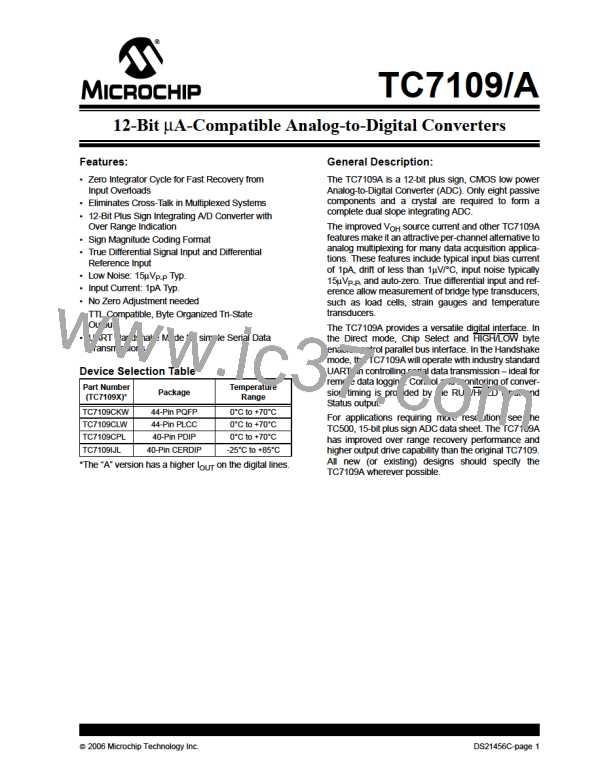TC7109/A
The MODE input controls the Handshake mode. When
the MODE input is held HIGH, the TC7109A enters the
Handshake mode after new data has been stored in the
output latches at the end of every conversion per-
formed (see Figure 3-7 and Figure ). Entry into the
Handshake mode may be triggered on demand by the
MODE input. At any time during the conversion cycle,
the LOW-to-HIGH transition of a short pulse at the
MODE input will cause immediate entry into the Hand-
shake mode. If this pulse occurs while new data is
being stored, the entry into Handshake mode is
delayed until the data is stable. The MODE input is
ignored in the Handshake mode, and until the
converter completes the output cycle and clears the
Handshake mode, data updating will be inhibited (see
Figure 3-9).
SEND input will be HIGH when the Handshake mode is
entered, after new data is stored. The high order byte
outputs become active and the CE/LOAD and HBEN
inputs will go LOW after SEND is sensed. When CE/
LOAD goes HIGH at the end of one clock period, the
high order byte data is clocked into the UART transmit-
ter buffer register. The UART TBRE output will go LOW,
which halts the output cycle with the HBEN output
LOW, and the high order byte outputs active. When the
UART has transferred the data to the transmitter regis-
ter and cleared the transmitter buffer register, the
TBRE returns HIGH. The high order byte outputs are
disabled on the next TC7109A internal clock HIGH-to-
LOW edge, and one-half internal clock later, the HBEN
output returns HIGH. The CE/LOAD and LBEN outputs
go LOW at the same time as the low order byte outputs
become active. When the CE/LOAD returns HIGH at
the end of one clock period, the low order data is
clocked into the UART transmitter buffer register, and
TBRE again goes LOW. The next TC7109A internal
clock HIGH-to-LOW edge will sense when TBRE
returns to a HIGH, disabling the data inputs. One-half
internal clock later, the Handshake mode is cleared,
and the CE/LOAD, HBEN and LBEN terminals return
HIGH and stay active, if MODE still remains HIGH.
When the MODE input is HIGH, or when the converter
enters the Handshake mode, the chip and byte enable
inputs become TTL compatible outputs, which provide
the output cycle control signals (see Figure 3-7, Figure
and Figure 3-9). The SEND input is used by the con-
verter as an indication of the ability of the receiving
device (such as a UART) to accept data in the Hand-
shake mode. The sequence of the output cycle with
SEND held HIGH is shown in Figure 3-7. The Hand-
shake mode (internal MODE HIGH) is entered after the
data latch pulse (the CE/LOAD, LBEN and HBEN
terminals are active as outputs, since MODE remains
HIGH).
Handshake output sequences may be performed on
demand by triggering the converter into Handshake
mode with a LOW-to-HIGH edge on the MODE input. A
handshake output sequence triggered is shown in
Figure 3-9. The SEND input is LOW when the
converter enters Handshake mode. The whole output
sequence is controlled by the SEND input, and the
sequence for the first (high order) byte is similar to the
sequence for the second byte.
The HIGH level at the SEND input is sensed on the
same HIGH-to-LOW internal clock edge. On the next
LOW-to-HIGH internal clock edge, the high order byte
(bits 9 through 12, POL, and OR) outputs are enabled
and the CE/LOAD and the HBEN outputs assume a
LOW level. The CE/LOAD output remains LOW for one
full internal clock period only; the data outputs remain
active for 1-1/2 internal clock periods; and the high byte
enable remains LOW for 2 clock periods.
Figure 3-9 also shows that the output sequence can
take longer than a conversion cycle. New data will not
be latched when the Handshake mode is still in
progress and is, therefore, lost.
The CE/LOAD output LOW level, or LOW-to-HIGH
edge, may be used as a synchronizing signal to ensure
valid data, and the byte enable as an output may be
used as a byte identification flag. With SEND remaining
HIGH, the converter completes the output cycle using
CE/LOAD and LBEN, while the low order byte outputs
(bits 1 through 8) are activated. When both bytes are
sent, the Handshake mode is terminated. The typical
UART interfacing timing is shown in Figure .
3.3
Oscillator
The oscillator may be over driven, or may be operated
as an RC or crystal oscillator. The OSCILLATOR
SELECT input optimizes the internal configuration of
the oscillator for RC or crystal operation. The OSCIL-
LATOR SELECT input is provided with a pull-up resis-
tor. When the OSCILLATOR SELECT input is HIGH or
left open, the oscillator is configured for RC operation.
The internal clock will be the same frequency and
phase as the signal at the BUFFERED OSCILLATOR
OUTPUT. Connect the resistor and capacitor as in
Figure . The circuit will oscillate at a frequency given by
f = 0.45/RC. A 100kΩ resistor is recommended for use-
ful ranges of frequency. The capacitor value should be
chosen such that 2048 clock periods are close to an
integral multiple of the 60Hz period for optimum 60Hz
line rejection.
The SEND input is used to delay portions of the
sequence, or handshake, to ensure correct data trans-
fer. This timing diagram shows an industry standard
HD6403 or CDP1854 CMOS UART to interface to
serial data channels. The SEND input to the TC7109A
is driven by the TBRE (Transmitter Buffer Register
Empty) output of the UART, and the CE/LOAD input of
the TC7109A drives the TBRL (Transmitter Buffer
Register Load) input to the UART. The eight transmitter
buffer register inputs accept the parallel data outputs.
With the UART transmitter buffer register empty, the
DS21456C-page 12
© 2006 Microchip Technology Inc.

 MICROCHIP [ MICROCHIP ]
MICROCHIP [ MICROCHIP ]